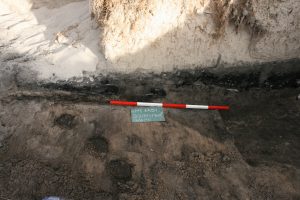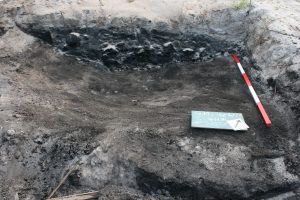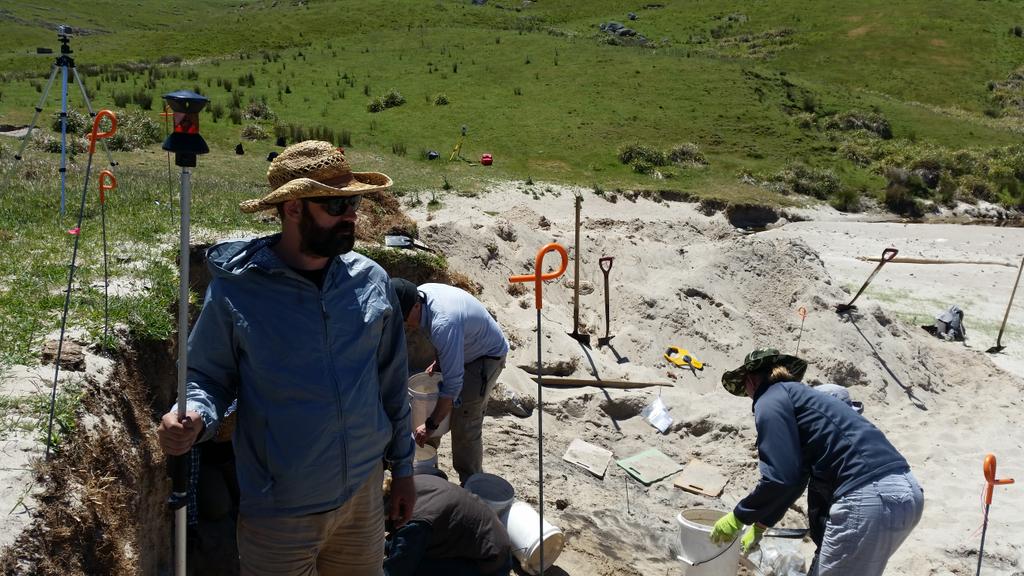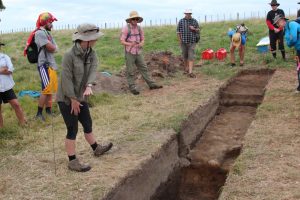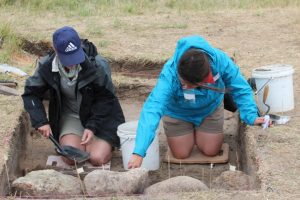Bones. Whether you’re wanting to walk upright or just design a really cool flag for your pirate ship, bones are absolutely invaluable. In archaeology, bones are invaluable because they can provide us with a great deal of useful information. But I’m getting ahead of myself…
Sunday saw the field school team enjoying a well-deserved day off, which was spent trekking around Ahuahu/Great Mercury Island and visiting the survey sites of previous field schools. Refreshed and relaxed after our weekend – and heartened by cloud cover providing some respite from days of beating sun – the team headed back into the field on Monday morning.
Excavation Area 64 (EA64) has proved to be somewhat of an enigma for the team. While it is clear that the site has been the location of one or more occupations, the sandy nature of the site makes interpretation of the archaeological record difficult. Why is this exactly? In short, sand is highly mobile. Think about this next time you’re at the beach. Take a step into the sand and what was once on the surface is now slightly lower. Now think about the all the other processes that can move grains of sand around (wind, rain, rivers, the ocean and animals are some examples) and you suddenly get an idea of just how tricky sand can be. This was the problem the team faced, but things were suddenly about to get a lot more exciting.
Days of excavation at EA64 had resulted in a great deal of artefacts and sites of past activity being uncovered, but suddenly towards the end of last week things began to slow down. Less and less artefacts were being discovered and while some of the team were still working on excavating hangi and fire features, it was thought that we’d uncovered most of the significant material in the trench area and were reaching what is known as a sterile layer. When this happens there are two courses of action; the first is to simply make the trench bigger by de-turfing an additional area and enlarging the excavation with the view of finding more material. The second is to dig smaller deeper pits – known as test pits – into the existing excavation area, again with the view of finding more material. Dr Louise Furey from Auckland Museum decided the best course of action was to dig a test pit and was immediately surprised to find that not only were there more artefacts to be uncovered, but that they were bigger and occurred with greater frequency than those found in the layers above. The team were back in business.
Obviously it would be a huge undertaking to dig the entire excavation down to the new layer, so in cases like this archaeologists hedge their bets somewhat and make an educated guess about which parts of the existing excavation to extend. It was decided to dig deeper on only two sides of EA64 and after a rousing speech by Alex Jorgensen the team were furiously digging with the view of reaching the depth of Louise’s test pit.
Suddenly Murphy’s Law – or a variant thereof – struck. New, larger, artefacts were being uncovered with astonishing frequency after only a few bucketfuls of sand had been removed from EA64 – testament to the tricky nature of sand; just when you think it’s game over, you’re on the next level. Literally.
So what did we uncover? Well, among copious amounts of large obsidian artefacts were chert flakes, fire cracked rock, and charcoal.
So what about bones?
Waiting underneath the sand layer which we previously thought to be sterile, was a small number of mammal bones, an exciting find for all on the field school, staff and students alike.
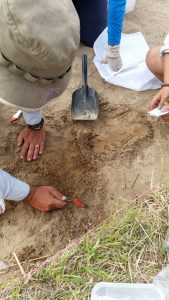
While, naturally, further excavation will be required to find out more about the mammal bones and what they can tell us, we can infer several things from this exciting find. The first is that we can now be relatively certain that animals were being killed – and perhaps cooked and eaten – at the site. Whether this find can tell us about a larger subsistence strategy on Ahuahu/Great Mercury Island remains to be seen, but bones can tell us many other things. For instance, perhaps the bones are from a mammal species that once lived in the area but were hunted to extinction – at least on a regional level – if we can compare this information against historical or ethnographic records, it may assist us in obtaining a relative date for the occupation of EA64.
As usual, the answers lie (mostly) in one place: underground.
Doug

